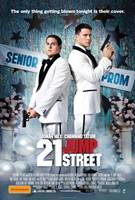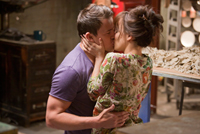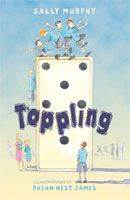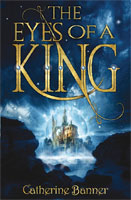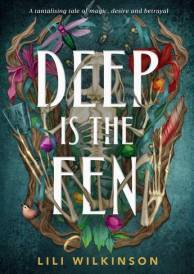Channing Tatum Foxcatcher
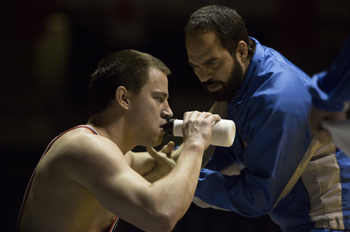
Channing Tatum Foxcatcher
Cast: Channing Tatum, Anthony Michael Hall, Steve Carell
Director: Bennett Miller
Genre: Drama
Rated: M
Running Time:134 minutes
Synopsis: Based on the true story of Mark Schultz, an Olympic wrestler whose relationship with sponsor John du Pont and brother Dave Schultz would lead to unlikely circumstances.
Foxcatcher
Release Date: January 29th, 2015
About the Production
Based on true events, Foxcatcher is a rich and moving story of brotherly love, misguided loyalty and the emotional bankruptcy that can accompany great wealth and power. Examining the perilous relationship between an eccentric multi-millionaire and two champion wrestlers, Academy Award® nominee Bennett Miller's fourth feature once again centers around complex characters with vivid personalities navigating unusual circumstances. As with his previous features, Capote and Moneyball, large and often allegorical themes in society emerge through Bennett Miller's meticulously imagined portraits of real people.
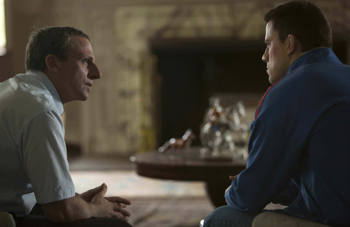 The mass of research collected during the years of preparation for Foxcatcher yielded the stark facts from which the drama would be created, transforming the story into a wholly new incarnation. 'It's fact to fiction as a vehicle back to truth," says Bennett Miller. 'Some months after Capote was released I received a letter from Harper Lee. She said the film was a demonstration of fiction as a means towards truth. There was, as she pointed out, a great deal in the film that we had invented, but that -The film told the truth about Truman.' Foxcatcher has a similar aim." Bennett Miller first heard about the story of eccentric multi-millionaire John Eleuthère du Pont (Steve Carell) and a pair of world champion wrestler brothers, Mark (Channing Tatum) and Dave Schultz (Mark Ruffalo) when executive producers Michael Coleman and Tom Heller showed him a newspaper article about the story. 'The circumstances seemed comical and absurd, but the outcome was horrible and real," says Bennett Miller. 'The deeply strange things that happened on the du Pont estate were unlike anything I had personally experienced, and yet they felt familiar. There was something about the story " or perhaps something beneath the story " that wasn't strange at all. In fact, the opposite."
The mass of research collected during the years of preparation for Foxcatcher yielded the stark facts from which the drama would be created, transforming the story into a wholly new incarnation. 'It's fact to fiction as a vehicle back to truth," says Bennett Miller. 'Some months after Capote was released I received a letter from Harper Lee. She said the film was a demonstration of fiction as a means towards truth. There was, as she pointed out, a great deal in the film that we had invented, but that -The film told the truth about Truman.' Foxcatcher has a similar aim." Bennett Miller first heard about the story of eccentric multi-millionaire John Eleuthère du Pont (Steve Carell) and a pair of world champion wrestler brothers, Mark (Channing Tatum) and Dave Schultz (Mark Ruffalo) when executive producers Michael Coleman and Tom Heller showed him a newspaper article about the story. 'The circumstances seemed comical and absurd, but the outcome was horrible and real," says Bennett Miller. 'The deeply strange things that happened on the du Pont estate were unlike anything I had personally experienced, and yet they felt familiar. There was something about the story " or perhaps something beneath the story " that wasn't strange at all. In fact, the opposite."
At the heart of Foxcatcher is a triangular dynamic between du Pont and the Schultz brothers that Bennett Miller found compelling " enough so to commit to making it his next film. But while his initial impulse to take on the project was immediate, the subsequent time and energy poured into it was expansive. 'I needed to learn what hadn't been known about the story and that takes time," says Bennett Miller. 'What compelled me was clear and convincing; I knew this was a story for me. But the process of summoning this film took years, involving relentless research and discovery that goes far beyond determining plot. My first undertaking was authoring and engineering the moments and sequencing that would become the film " a process that allowed the film to continue to reveal itself all the way through to the last detail in post-production."
Bennett Miller traveled all over the country " to Iowa, California, Colorado, Missouri, and Pennsylvania " amassing materials, including video footage of both du Pont and the Schultz brothers, and interviewing dozens of people, including Mark Schultz, Dave's widow Nancy, their friends and fellow wrestlers, people who had worked for du Pont, police officers, and anyone who had lived any part of the story. "This story harbors some uncomfortable truths," says Miller. "Everyone I spoke with seemed to be guarding some aspect of what happened."
The basics of the story revealed the following: Although Dave was slightly older than Mark, the siblings did not have a typical brotherly relationship growing up. After their parents split up when they were young, Dave assumed a paternal role as they moved between their parents' homes, often fending for themselves. Over time, Mark developed a need for his brother, as wrestling partner or coach, or for emotional support. At the same time, he was jealous of Dave's success. His inner turbulence only escalated as the years went by. 'Mark was always that little brother that just couldn't break out or figure out how to get by on his own," says Channing Tatum. 'He always had to rely on Dave, and this kept him from having his own life, his own career, and the thing he wanted most"his own respect from people." Mark's confused vulnerability made him frequently turn his pent-up anger on himself as much as on his wrestling opponents. 'I don't think anybody could punish Mark more than he could himself and I think he hardens himself against the world by punishing himself," says Channing Tatum.
In the summer of 2006, Bennett Miller approached veteran producer Jon Kilik and laid out his initial vision for the project. Jon Kilik (The Diving Bell And The Butterfly, Babel, Dead Man Walking) remembered the Schultz story from news reports and immediately responded to the director's meticulous clarity of vision even in the earliest stages of Foxcatcher. "Bennett Miller described the essential scenes in detail and it had instant impact," says Jon Kilik. "The basic conflict resonated with me from the opening " the notion of Mark having achieved what he had, only to come home to abject loneliness, an assistant coach's salary and barely any recognition for winning Olympic gold " right through to the story's heartbreaking end. It was clear from the project's inception that Bennett had the relentless drive and passion to fulfill his singular vision. I was ready to spend time with him developing the script and getting the movie made."
Bennett Miller developed the project with different writers over time. "I had the good fortune of working with two extremely smart and gifted writers," says Bennett Miller. "Though we worked separately over the course of the project, their work was compatible and of a piece with how I envisioned the film. This is not one of those cases where one writer undoes the work of another " both writers made profound advances towards the same end." The story was researched and generally outlined before it went out to screenwriter E. Max Frye (Something Wild), who helped bring the wildly disparate facts of the story into focus. "It's not often that a writer gets to collaborate with a director who possesses such singular vision," says E. Max Frye. "Building a detailed, complex narrative based on character as opposed to simply constructing a plot is what makes Bennett Miller's approach to storytelling so compelling. From the moment I met with him, I was impressed by his unrelenting focus on people and what makes them do the things they do. Throughout a long and often difficult process, he never lost sight of the story he wanted to tell even when that story seemed to be at the top of a mountain too high to climb. The fact that it took him eight years to make this movie is testament to his determination and resolve and I'm proud to have played a part in that."
Bennett Miller next turned to previous collaborator Dan Futterman " whose screenplay for Capote resulted in a Best Adapted Screenplay nomination at the 2006 Academy Awards " for further development on the project. "Dan Futterman has a great analytical mind and a divining rod for what matters in a story," says Miller. "After Max's contribution, I was looking for a similar experience to the one we shared on Capote, where we could methodically go through every beat of the story and challenge and evaluate every decision." Dan Futterman immersed himself in the existing research, observing a wrestling tournament and conducting interviews with Mark Schultz and Nancy Schultz, Dave's widow. Working closely with Bennett Miller, the screenwriter produced several revisions that, among other things, crystallized the triangular power dynamics between the three central characters. "In addition to his prodigious and more obvious talents, Bennett Miller's attention to detail is unparalleled. He questions and pores over every moment in the script, every beat of performance, every frame of editing," says Dan Futterman. "Foxcatcher is his film " the story he's been wanting to tell for the last eight years. I've been blessed to have Bennett Miller bring to onscreen life two screenplays I've written or co-written " Capote and now Foxcatcher."
While waiting on financing for the film to come through, Bennett Miller was able to cast his three primary actors long before Foxcatcher began production. This allowed Channing Tatum, Mark Ruffalo and Steve Carell sufficient time to immerse themselves in the lives of the real people they would be playing " a process they took very seriously. 'You have a responsibility playing a real person and I wanted to honor Dave to the best of my abilities," says Mark Ruffalo. 'The only way I knew how to do that was to go out in the world and find out as much as I could about him. There's no small amount of reportage involved in the job "you're like a detective in a way." Mark Ruffalo became very close to Dave's wife Nancy and other people who knew him well, including John Giura, Dave's coach and one of his best friends, who was later hired as a wrestling and training coordinator on the film.
Neither Channing Tatum nor Mark Ruffalo were skilled wrestlers when they signed on to play Mark and Dave Schultz. Both had to learn the brothers' signature stances, moves and styles, which were well known by Giura and heavily documented on video. The actors began training separately with wrestling choreographer Jesse Jantzen in June 2012 and then trained together during regular workouts when shooting began in in October. Even though Ruffalo had done some wrestling in high school, it proved a liability, since Dave Schultz was left-handed; as a 45-year-old man, he had to unlearn everything he knew as well as make himself convincing as a 33-year-old man considered by many to be the greatest wrestler ever. The training sessions were grueling and often continued into the night after long days of filming outside Pittsburgh. 'I challenge anyone who thinks their sport is harder to come and try it," says Channing Tatum. "This has been the most painful movie I have ever done. I never want to wrestle again."
The intricate physical and emotional dynamic between the Schultzes is vividly illustrated in one of Foxcatcher's most memorable scenes, an early practice maneuver that turns into unexpected violence. It begins like a dance, with Dave effortlessly ushering Mark through some moves, lightly correcting and instructing his younger brother. 'There is real tenderness between them and so much unspoken communication," says Mark Ruffalo. 'It's as intimate as two men can be without being lovers." Gradually Mark's complicated feelings about Dave spill out and compel him to amp up the aggression and inflict harm on the brother he idolizes. 'Mark is so much bigger, stronger and more aggressive " you can see he is exceptionally gifted on the mat," says Bennett Miller. "But Dave still has the psychological edge on him." Adds Bennett Miller: "In this scene, you see Dave's steadfastness, his fairness and his love, but you simultaneously see his status. He's the Alpha. Not an uncaring, unsympathetic, unloving Alpha, but an Alpha."
To prepare for this crucial scene " the only time Channing Tatum and Mark Ruffalo wrestle together in the film " the actors worked separately and in tandem with wrestling coordinator John Giura, an Olympic-caliber wrestler in his own right who actually lived on the du Pont estate as part of Team Foxcatcher at the time of Dave's murder. "Every move in that scene was choreographed," says John Giura. "For them to do it without hurting each other was tricky and it would get to the point where they became frustrated. You can see this in the film. But it was amazing to witness both actors overcome their frustrations on camera. A wrestler who has trained for ten years and has 100 matches behind him can get by on instinct alone. But an actor who has been training for four months simply doesn't have that in his DNA. He has to constantly think about what he is doing. The work that Channing Tatum and Mark Ruffalo put into their training really shows on screen."
The brothers' complicated relationship, epitomized in the dance-like practice scene, comes to a boil with Mark's realisation that Dave was beginning to move on with his life, to pursue his own family and career beyond his Olympic glory. "There's a deep connection between them " what some people might call a codependency, which became unhealthy as they moved into the world," says Mark Ruffalo. "As Dave embarked on his adult life, Mark saw it as a betrayal. It became an impossible situation because Dave knew that Mark didn't have anything at all in his life besides wrestling and their relationship."
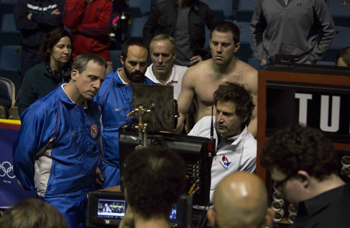 It's at this time " when Mark is at his lowest ebb " that John du Pont invites him for a life-changing meeting at Foxcatcher Farm, showering him with words of praise and respect he had long sought from a paternal figure. "Mark had a lot of trepidations and issues with trust but here was somebody who saw him and his brother in a way he felt they deserved," says Channing Tatum. "Du Pont called the Schultzes heroes who fought for their country. He made Mark believe that no one would support him or care about him like he did. Mark began to see that this was the best opportunity he had ever been given. Finally he could get the attention, respect and accolades he always wanted " and he could separate himself from Dave."
It's at this time " when Mark is at his lowest ebb " that John du Pont invites him for a life-changing meeting at Foxcatcher Farm, showering him with words of praise and respect he had long sought from a paternal figure. "Mark had a lot of trepidations and issues with trust but here was somebody who saw him and his brother in a way he felt they deserved," says Channing Tatum. "Du Pont called the Schultzes heroes who fought for their country. He made Mark believe that no one would support him or care about him like he did. Mark began to see that this was the best opportunity he had ever been given. Finally he could get the attention, respect and accolades he always wanted " and he could separate himself from Dave." Du Pont himself was burdened by a family legacy that was nearly impossible to uphold because it went back so many generations, culminating in a cold, unaffectionate mother who lavished her attention on her prized horses. "Wrestling became very important to John because it was a vocation of his own choosing and it didn't apply to other parts of his upbringing," says Steve Carell. "His mother was not a fan of the sport and thought it barbaric. He stepped out from her shadow in that way." Du Pont had tried to make his mark on the world in numerous ways: as ornithologist, conchologist, philatelist, philanthropist, trainee for the Olympic pentathlon, and benefactor to sports of all kinds. Instead he became the savior of the U.S. Olympic wrestling community, building the Foxcatcher training facility and becoming the leading funder of the sport. "He was highly competitive and yearned for respect," says Steve Carell. "I think he wanted people to look up to him in the way they looked up to Dave Schultz. He wanted to be one of the guys yet still be held in a somewhat higher regard than others. Ultimately he was unable to earn that kind of esteem and admiration."
Steve Carell's fans will be surprised to see him in a role as dark and challenging as John du Pont, a man of immense wealth and power whose downward spiral culminates in murder and imprisonment. Bennett Miller knew from the outset that the actor could play awkward, eccentric, and even violent. He also knew that it was useless to try and cast a conventional or expected actor in the role of a character whose nature was so unexpected. "Nobody believed what du Pont was capable of," says Bennett Miller. "But when I met Steve Carell I realised how many layers there are to him " he is one of those actors with a public self and a private self. And you never see the private self, ever. I thought those protected, guarded areas might help him to relate to this character in some way." Steve Carell himself found the transformation challenging but is reluctant to pass any easy judgment on du Pont. "I don't see him as a monster," he says. "He's someone who was suffering from mental illness and did something terrible. He was a very sad, damaged human being."
To prepare for the exacting role, Steve Carell studied du Pont's physical demeanor and speaking manner by watching hours of the Team Foxcatcher video footage Bennett Miller provided his cast. "I listened to his cadence " not only how he spoke physically, but the actual words he chose to express himself," says Steve Carell. "Bennett Miller would sometimes have us improvise, so I allowed room for that. But there were certain affectations that were specific to him which I thought were important and lead with." His fellow actors were unprepared for the total transformation Steve Carell brought when he arrived on set, already in character. "When Steve Carrel first walked out as du Pont, it gave me a shiver," says Mark Ruffalo. "In the thousands of hours of video footage I watched to prepare myself, two hundred of them included Dave interacting with du Pont in a coaching capacity. So I became very intimate with that man " who he was, how he sounded, how he moved. Steve Carrel's ability to capture the physical qualities of du Pont was creepy and uncanny." Some found Carell's demeanor to be deeply disturbing. "It was uncomfortable to be around Steve Carrel as John du Pont," says Nancy Schultz, Dave's widow, and a frequent presence on set during filming. "He stayed in character most of the time and it was very unsettling to catch a glimpse of him out of the corner of my eye." One of the world's greatest actors, Vanessa Redgrave joined the cast as John du Pont's formidable mother Jean. Bennett Miller was impressed by Vanessa Redgrave's willingness to improvise but takes no credit for shaping her work in any way. "Working with Vanessa was more about watching it happen," says Miller. 'I really didn't do much. We had different versions of a scene written and I asked her if she was okay winging it, and she was. She just went out on a tear, giving this long monologue of stuff that wasn't written." Both Steve Carell and Vanessa Redgrave were delighted to work together on what was for both actors very challenging material. "Vanessa Redgrave improvised a lot, but in every take she embodied the formidable strength of her character," says Steve Carell. "Interestingly, Jean du Pont was physically very frail, but Vanessa Redgrave helped bring enormous strength and power to her relationship with my character." Adds Vanessa Redgrave: "Steve Carell was super to work with because his concentration is total. I really enjoyed my scenes with him."
When it came time to cast the Foxcatcher team and other wrestlers in the film, the production needed to secure the support of the U.S. wrestling community " a notoriously close-knit group for whom there was some trepidation regarding the film's tone, considering the tabloid nature of the story. Some wrestlers had no compunctions about informing Ruffalo that he was hardly their ideal casting for Dave Schultz. Mark Ruffalo attended the first big audition, which included some of the leading wrestlers in the country as well as some of Dave's close friends. 'I was just there to say hello but Bennett Miller had me suit up and wrestle with the guys," says Mark Ruffalo, 'This was actually an audition for me to win them over " I knew I couldn't blow it." With the pressure already on, Ruffalo's first opponent was a noted Olympic wrestler. 'Dave used to start strong, so I threw one of his signature moves, one of the more showy ones," says Mark Ruffalo. 'And I looked up and Tadaaki Happa " one of the great Olympic wrestling coaches " gave me a nod of respect."
Mark Ruffalo's 'audition" was a turning point for the wrestling community's support of the movie. 'After that, it was -whatever you guys want, whatever you need, we're here " we believe in this project," says Mark Ruffalo. 'I feel like I got the blessing of the people I needed to please and it meant a lot to me."
Channing Tatum was the only one of the three lead actors who had to perform in front of the real-life person he was playing, as Mark Schultz " now a wrestling coach based in Oregon " became a welcome and often indispensible presence on set during filming. "Having him there was unbelievably helpful at times in terms of the information he was able to provide," says Channing Tatum. "But it was also confusing trying to separate Mark's real-life emotions from my own as I was trying to play him in the film. I think it was difficult for Mark to watch me work." (The real Mark Schultz appears in a cameo in the film, in the scene where Mark weighs in for the World Championships after dropping weight).
Sienna Miller, who plays Dave's wife Nancy, also benefited from having her real-life character on set for easy consultation. "It was incredible to be around her but at the same time it was surreal, because I was dressed as her," says Sienna Miller. "But she was very open and willing to share her ideas, thoughts and memories " even painful ones. She was as supportive as she could have been, but it was also nerve-wracking in a way. Because when you're playing someone who not only existed, but is still alive, it's a huge responsibility." Miller was particularly impressed by Nancy's fortitude on set, especially during scenes that conjured up harrowing memories of her husband's murder, which Nancy witnessed. "Obviously she experienced something deeply traumatic " you can see in her eyes that she's been through things and come out the other side stronger for them," says Sienna Miller. "I think what's beautiful about this story and her role is that Nancy and Dave play the part of the nurturing, familial side. They are the antithesis of the John du Pont and Mark Schultz dynamic."
For as much as the actors researched their roles by either relying on video footage or their characters' true-life counterparts, no amount of preparation compares to the magic moment on set when improvisation takes over " something Bennett Miller encouraged in his cast members. "It was our job to research our characters as best we could but inevitably it became something else when we were filming," says Steve Carell. "There were scenes that had been rehearsed and discussed that changed completely while we were doing them." For Tatum it was challenging to go off-script at Bennett Miller's behest. "Bennett would have me on set and he'd say 'Do whatever you think Mark would do'," says Channing Tatum. "It was fun but at the same time it was hard work " you don't know what's going to wind up in the movie, so you have to stay extremely focused." Anthony Michael Hall, who plays du Pont's assistant, Jack, says of the process: 'Bennett Miller was molding the performances of the actors " he was pushing them and at the same time freeing them up. They had done their homework, and now, in a very deliberate and understated way, he was getting them to bring these real people to life."
Bennett Miller was able to work with such a free approach because he had the full backing of his producer, Megan Ellison and Annapurna Pictures. While Annapurna has since become known for such acclaimed films as The Master, Zero Dark Thirty, Her, and American Hustle, Foxcatcher was in fact one of the first projects the company took on. 'Making a film like this, which is not a predetermined, connect-the-dots, color-within-the-lines kind of project, requires a leap of faith on the part of the producers and the actors," says Bennett Miller. "It's almost like going into a documentary, where you don't know exactly what form it will take when it's finished. The only way for the film to become what it needs to become is to go into it with a question mark."
In the same way the cast members brought veracity to their roles as true-life people, Bennett Miller and his crew sought to show the sport of wrestling on screen in a way that was both authentic and visceral. "Bennett Miller wanted to make the most authentic wrestling movie ever because it would make everything else in the movie ring true," says Giura, the film's wrestling coordinator, whose job was to hire the actual wrestlers who appear alongside Tatum and Ruffalo in the fighting sequences. "We researched every possible match from the video footage and recreated every move from the actual matches that we showed in the movie. Because (director of photography) Greig Fraser had captured all the right footage during filming, we were able to put together the matches effectively during the editing process."
Giura himself contributed a large amount of archival wrestling footage to Bennett Miller's existing research stash, much of it culled from matches he filmed while competing with the Schultzes around the U.S. and overseas during the 1980s " footage he had been unable to look at for two decades due to his closeness with both Schultz brothers. "We had a computer with a giant screen in the training room, so we had all the footage we needed at our fingertips during filming," says Giura. "Both actors really appreciated this. They felt more comfortable seeing actual people wrestling, in some cases Mark and Dave themselves. Mark Ruffalo did a great job of teaching technique like Dave actually taught it " he could run through it backwards and forwards effortlessly. He had to learn Dave's whole technique inside and out. With the help of the video footage, he nailed it."
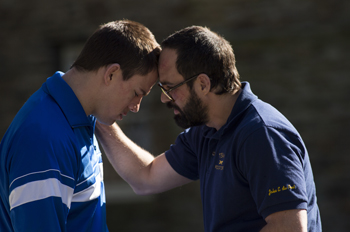 For Fraser's part, wrestling was a new sport, something he had never much studied or even watched, but likened to a beautiful dance between two gifted and talented performers. "My lack of familiarity with the sport gave me an advantage over someone who knew it inside and out," says Fraser, who watched hours of video footage to help create a strategy for the wrestling visuals in the movie. "If you watch good wrestling coverage you notice that if an editor cuts too often or too quickly you can lose perspective. So I tried to focus on a key spot for each move. We worked closely with the coaches and then we would film the choreography. Afterward, we'd discuss as a team the best angles for each shot. The idea was to allow the editors to cut the least amount as possible " to show as much of the dance as you could."
For Fraser's part, wrestling was a new sport, something he had never much studied or even watched, but likened to a beautiful dance between two gifted and talented performers. "My lack of familiarity with the sport gave me an advantage over someone who knew it inside and out," says Fraser, who watched hours of video footage to help create a strategy for the wrestling visuals in the movie. "If you watch good wrestling coverage you notice that if an editor cuts too often or too quickly you can lose perspective. So I tried to focus on a key spot for each move. We worked closely with the coaches and then we would film the choreography. Afterward, we'd discuss as a team the best angles for each shot. The idea was to allow the editors to cut the least amount as possible " to show as much of the dance as you could." Principal photography for Foxcatcher began in October 2012 in and around Pittsburgh. Several estates in the vicinity were employed to capture different aspects of the original du Pont estate, Foxcatcher Farm, which changed hands several times in the years since John du Pont's incarceration and death and now serves as the campus for the Episcopal Academy preparatory school. A private home in Newton, Pennsylvania, on 500 acres of land, including a horse farm, provided many of the interiors and exteriors, with the exception of the dramatic Greek-revival façade of du Pont's sumptuous living quarters, which was filmed on a property in Northern Virginia. "What we couldn't find around Pittsburgh was a large exterior that stood proud in the middle of a great field, with columns and a fortress-like structure," says Jess Gonchor, the film's production designer. "We were able to shoot key exteriors in Virginia and mix them in with the interiors in Pittsburgh." Adds Fraser: "We tried to keep a common thread in terms of mood and feeling throughout the film despite multiple locations in separate states. It was always about piecing together different places to create a consistent visual image of the Foxcatcher estate."
For Fraser, who shot Foxcatcher on film using a series of Panasonic XL cameras, the look and feel changed depending on the location " resulting in the use of lenses from different eras to convey constriction and widening scope during crucial moments of the plot. "It's a decidedly dark story but I didn't need the visuals to be dark " I only needed them to be honest in terms of the drama," says Fraser. "We had a story to tell visually in terms of these characters' progressions and we achieved this for the most part through progressions of lenses and lighting to help propel Mark's journey throughout the story." For example, during early scenes in Mark's dank, cramped apartment atop a garage in Wisconsin, Fraser chose lenses that faithfully recorded that image of a man alone eating noodles in the dark. "But when he's opened into this wider world of the du Pont estate, we chose to regress slightly in terms of the lenses," says Fraser. "We used lenses that were 30 years old, which gave the scenes a softer quality without resorting to filters that would degrade the image. I wanted the viewer to see the world like Mark did when he first arrives at the estate " through rose-colored lenses, which helped to propel that subplot along."
It was also crucial for Fraser to create a feeling of the world opening up when Mark first flies over the estate by helicopter " to contrast the claustrophobia and malaise that Mark experienced during his post-Olympics life in Wisconsin. Camera placement also played a crucial role in creating a kind of psychological suspense that builds as the story expands. "We wanted to widen our scope in that regard but it's also the moment when the noose begins to tighten around Mark's neck," says Fraser. "To further tighten that noose, we put him in wrestling facilities with low ceilings that were lit with fluorescent lights. If you place the camera low to the ground, it feels imposing and grand " you're more on the level with the wrestlers. But if you put the camera up higher, as we did in key scenes, it begins to feel claustrophobic, like the noose is tightening even more."
Because the film is set predominantly in the 1980s and '90s, architecture, color and wardrobe had to convey a certain look and feel without resorting to caricatures or clichés of the era. For Gonchor, a major challenge in creating the Foxcatcher interiors came from reflecting the solitary nature of both Mark Schultz and John du Pont as they come to grapple with their complex relationship amid the interiors of Foxcatcher Farm. "I'm interested in the notion of character dressing, or stripping away the bare essential to convey a feeling of loneliness," says Gonchor. "For me du Pont was a loner, this solitary figure in his grand office. In the back of my mind it was the Oval Office and he was the commander in chief, with nobody to command. His mother's room, in contrast, felt like it had no personality " only pictures of her favorite things, including horses. Mark comes to live in their lavishly appointed guest home, the opposite of his tiny apartment in Wisconsin. Both places were mired in stillness and loneliness. Only the trophy room on the estate was over the top, because the mother was so proud of it."
For costume designer Kasia Walicka Maimone, whose recent work includes Wes Anderson's Moonrise Kingdom and J.C. Chandor's A Most Violent Year, the wardrobe in Foxcatcher was heavily based on her own research, including photos and video from the era, books on the du Pont family, long talks with the wrestling community, and extensive preparation work with Bennett Miller, with whom she previously collaborated on Capote and Moneyball. Giura provided her with authentic wrestling singlets from the era, which she duplicated in number for the Foxcatcher team. Other articles were remade based on her research. Although technically a period piece, the costume design in Foxcatcher doesn't reflect some of the more garish looks of the late 1980s, the era in which the film is predominantly set. Indeed, many of the garments are subtle and subdued, in keeping with the quieter textures and color schemes in the production design. "The story is strong enough that it doesn't need propping up by costumes," says Walicka Maimone. "My job was to find the underlying design of the film and make the clothes fit seamlessly within the frame alongside the other elements. Once I knew how to communicate the multiple layers of the characters, it became easy for me to look for their skin."
The sense of stillness that looms over Foxcatcher in everything from the cinematography and the art direction to the performances and even the costumes is something cast and crewmembers attribute to Bennett Miller's predilection for the cinematic slow burn. "Bennett Miller's movies build on you quietly, he doesn't use a lot of moving parts," says Gonchor. "Aside from some bold statements we made with the architecture " or when Mark walks into the Foxcatcher gym for the first time in a burst of color " my work was supporting the acting and the script. The tone of the story is briefly hopeful and rousing during the wrestling sequences, but things become more lifeless and motionless as the story builds, until there is no sign of hope. At times even the scenery even feels dead." Adds Fraser: "We essentially let the story create its own visuals. We wanted to be honest and clear with the drama without getting too bogged down in making it look era-specific."
Throughout the filming and later on in the editing, Bennett Miller made every effort to distill the meanings of scenes down to their essence, emphasizing visuals whenever necessary. Fittingly, a large portion of Foxcatcher plays out wordlessly. 'Bennett Miller believes that character and story are enough to carry us through long periods of silence," says Mark Ruffalo. 'He isn't afraid to let a movie breathe in this way." Adds Tatum: 'He sees the little things. He's obsessed by the moments in between. What most people will see when you wrestle is the big moves " the big huge slams, the activity " but Bennett Miller really focuses on those quiet moments, when someone goes in his head when he's not doing the big moves."
Mark Ruffalo likens Bennett Miller's unique filmmaking process to the metaphor of a Zen rock garden. "You see a rock sticking out of the soil, but it's only a small percentage of what's buried and out of sight," says Mark Ruffalo. "The meditative glimpse of the story you get in this film is so profound, but at the same time you still have this sense of a much deeper, denser story underneath. He doesn't tie it all up neatly for us. He leaves us very much in the same place that most of the people who experienced this kind of tragedy have been left. Which is wondering how this happened, and why it came to pass?"
Bennett Miller himself describes his process as shining a light in places that no other medium can. "The language of movies in not simply fact-based but ideally it's totally truthful," says Bennett Miller. "What can be exposed within moments and communicated wordlessly is the reason why this is a film and not an article or news story."
The du Pont Family
A vast dynasty of industrial enterprise and wealth, the du Pont family has one of the oldest and most prestigious legacies in American history.
The family traces its origins to France in the late eighteenth century. Pierre du Pont, one of the family's oldest known relatives, was a confidante to King Louis XVI; his son, Eleuthère Irénée du Pont, was an apprentice to Antoine-Laurent de Lavoisier, a man considered to be the father of modern chemistry. At a time when the French were known for making the best gunpowder in the world, Eleuthère Irénée was able to learn the fine points of its manufacturing. Unfortunately, the French Revolution cut short Eleuthère Irénée's apprenticeship, and he fled France for America with Pierre and the rest of the DuPont family in October of 1799.
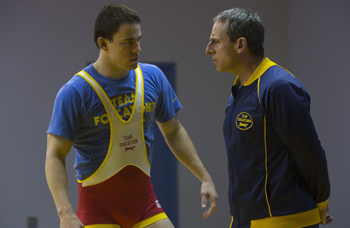 Soon after Eleuthère Irénée's arrival in the United States, he became aware of the poor quality of the gunpowder being manufactured there. Seeing an opportunity, he opened his own black gunpowder mill in Wilmington, Delaware along Brandywine Creek in 1802. Applying his sophisticated knowledge of the manufacturing process, Eleuthère Irénée du Pont created a product that would impact the course of United States history for nearly two hundred years. Eleuthère Irénée saw great success with the DuPont Company (while the family name is du Pont, the company is now referred to as DuPont) in his lifetime, but he also experienced tragedy when a series of explosions killed numerous workers at the mill in 1818. When rapidly accumulating debts put DuPont's future at risk, Eleuthère Irénée's son, Alfred Victor, took over the leadership of the company. Unfortunately Alfred lacked the skills to save the company and after a decade of his management, DuPont was more than half a million dollars in debt. At this point, Henry du Pont, Alfred's younger brother and Eleuthère Irénée's youngest son, was asked to step in. Henry was a West Point graduate and he immediately applied the discipline and leadership skills he learned there to provide fiscal stability for the company. As the DuPont Company stabilized under his guidance, Henry's nephew and Alfred's son Lammot du Pont emerged as a new force. Lammot was a gifted chemist with an impressive knack for business who at the age of twenty-seven fashioned a new form of blasting powder. Working together, Henry and Lammot were responsible for the company's great successes in the late 1800s, when they were able to capitalize on the huge demand for their munitions resulting from the Civil War, as well as the railroad expansion in the American West. DuPont would go on to be the largest supplier of military explosives for the U.S. in the First World War and later become the creator of Nylon, Teflon, Mylar, Kevlar and Lycra.
Soon after Eleuthère Irénée's arrival in the United States, he became aware of the poor quality of the gunpowder being manufactured there. Seeing an opportunity, he opened his own black gunpowder mill in Wilmington, Delaware along Brandywine Creek in 1802. Applying his sophisticated knowledge of the manufacturing process, Eleuthère Irénée du Pont created a product that would impact the course of United States history for nearly two hundred years. Eleuthère Irénée saw great success with the DuPont Company (while the family name is du Pont, the company is now referred to as DuPont) in his lifetime, but he also experienced tragedy when a series of explosions killed numerous workers at the mill in 1818. When rapidly accumulating debts put DuPont's future at risk, Eleuthère Irénée's son, Alfred Victor, took over the leadership of the company. Unfortunately Alfred lacked the skills to save the company and after a decade of his management, DuPont was more than half a million dollars in debt. At this point, Henry du Pont, Alfred's younger brother and Eleuthère Irénée's youngest son, was asked to step in. Henry was a West Point graduate and he immediately applied the discipline and leadership skills he learned there to provide fiscal stability for the company. As the DuPont Company stabilized under his guidance, Henry's nephew and Alfred's son Lammot du Pont emerged as a new force. Lammot was a gifted chemist with an impressive knack for business who at the age of twenty-seven fashioned a new form of blasting powder. Working together, Henry and Lammot were responsible for the company's great successes in the late 1800s, when they were able to capitalize on the huge demand for their munitions resulting from the Civil War, as well as the railroad expansion in the American West. DuPont would go on to be the largest supplier of military explosives for the U.S. in the First World War and later become the creator of Nylon, Teflon, Mylar, Kevlar and Lycra. The du Pont family's steadfast commitment to hard work has resulted in a dynasty and fortune unrivaled in American history. Today the du Pont name stands for a global company that has been on the leading edge of technological innovation for over two centuries. The DuPont Company is currently valued at fifty billon dollars and serves more than seventy countries around the world.
John Eleuthère du Pont was the great-great-grandson of Eleuthère Irénée du Pont.
Foxcatcher
Release Date: January 29th, 2015
Have You Seen This?
MORE



